Over the past few decades, the role of women as leaders has experienced rapid development in various fields. While leadership positions were once dominated by men, today women are increasingly demonstrating their capacity and competence in leading various sectors, including government, business, education, and social communities.

Challenges Still Faced by Women as Leaders
Women are increasingly demonstrating their leadership roles in various fields, from government, business, and the social sector. While these achievements are commendable, women still face various obstacles in fulfilling their leadership roles. These challenges stem not only from external factors but also from social and cultural constructs that have been ingrained for years.
Gender Stereotypes
One of the biggest challenges still frequently encountered is gender-based stereotypes. Women are often perceived as less assertive, less emotional, or less suited to strategic positions that require quick, high-stakes decision-making. This perception leads to doubts about women’s abilities, both from those around them and from within themselves.
Gap in Access and Opportunity
Although women’s competencies are comparable to those of men, access to leadership opportunities is often unequal. Many organizations still prioritize men for top positions. Non-inclusive promotion processes, the underrepresentation of women in professional networks, and the lack of gender-sensitive leadership training contribute to this inequality.
Double Burden
Many women face dual responsibilities, fulfilling leadership roles at work and managing households at home. The lack of adequate support systems, such as generous maternity leave or childcare facilities, often leaves women experiencing physical and mental exhaustion. This situation can impact the quality of their performance and lower their confidence in carrying out leadership roles.
Lack of Role Models
The lack of women as leaders to look up to is a challenge in itself. When strategic roles are predominantly filled by men, it is difficult for younger women to imagine that they too can achieve leadership positions. Yet, the presence of representative figures plays a crucial role in fostering hope and encouraging progress.
Bias in Leadership Assessment
Women are often judged against a double standard. While assertiveness in men is perceived as strong leadership, in women it can be seen as harsh or unfeminine. Conversely, when women are gentle, they are seen as weak or incompetent. This inequality forces women to strive harder to demonstrate their qualities and capacities.
Future Hope for Women in Leadership
Women’s journey to leadership is fraught with challenges, but it is undeniable that progress has been made. Today, more and more women are successfully occupying strategic positions, demonstrating their capacity as competent, virtuous, and innovative leaders. However, the struggle is not over. The hope for the future is to create a more just, open, and supportive environment for women to continue developing as leaders.
More Inclusive Leadership
A crucial step forward is to promote a more inclusive leadership system. The workplace and public institutions need to provide equal space for women to contribute and take on important roles in decision-making. Equality is not just about quotas, but about valuing potential and contributions regardless of gender.
Support from Various Stakeholders
Change will not happen without collaboration. Support from the government, business world, society, and family environment is essential for women to develop their leadership potential to the fullest. Training programs, mentoring, and gender-friendly policies are essential foundations for creating a sustainable leadership ecosystem.
Increasing Representation and Inspiration
Women as leaders who have successfully led deserve the opportunity to stand out and set an example for future generations. Strong representation will foster confidence that becoming a leader is not an impossible dream, but a real choice that anyone can achieve.
Changing Societal Mindsets
The biggest change begins with perspective. Society needs to shift outdated perceptions that limit women to specific roles. Leadership is no longer the preserve of one gender, but belongs to all individuals who have the capacity and determination to bring about change.
In the video from Lostamastaa, the role of women in leadership is presented as a force capable of changing the course of world politics. Women with leadership skills demonstrate great potential in driving meaningful change.
The hope for the future is a world that provides equal space for women and men to lead. When women are leaders, their quality will be enriched with diverse perspectives, experiences, and values. Women as leaders is not just the present, but the future, which must be continuously fought for together. /satya



